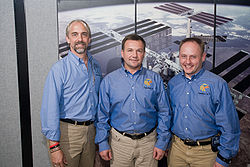Soyuz TMA-13
| Mission emblem | |||
|---|---|---|---|

|
|||
| Mission dates | |||
| Mission: | Soyuz TMA-13 | ||
| COSPAR-ID : | 2008-050A | ||
| Spacecraft: |
Soyuz 7K-STA ( GRAY index 11F732) serial number 223 |
||
| Launcher: | Soyuz FG (GRAY index 11A511FG) | ||
| Call sign: | Титан (" Titan ") | ||
| Crew: | 3 | ||
| Begin: | October 12, 2008, 7:01 UTC | ||
| Starting place: | Baikonur 1/5 | ||
| Space station: | ISS | ||
| Coupling: | October 14, 2008, 8:26 UTC | ||
| Decoupling: | April 8, 2009, 03:55 UTC | ||
| Duration on the ISS : | 175d 20h 31min | ||
| Landing: | April 8, 2009, 07:16 UTC | ||
| Landing place: | Kazakhstan, 151 km NE of Sheqasghan 48 ° 34 ′ N , 69 ° 23 ′ E |
||
| Flight duration: | 178d 0h 15min | ||
| Team photo | |||
 v. l. No. Richard Garriott, Juri Lontschakow, Michael Fincke |
|||
| ◄ Before / After ► | |||
|
|||
Soyuz TMA-13 is a mission name for the flight of the Russian spacecraft Soyuz to the International Space Station (ISS) . As part of the ISS program, the flight is designated ISS AF-17S. It was the 17th visit by a Soyuz spacecraft to the ISS and the 123rd flight in the Soyuz program.
crew
Starting crew
- Yuri Walentinowitsch Lontschakow (3rd space flight), Commander (Roskosmos / Russia)
- Michael Fincke (2nd space flight), flight engineer (NASA / USA)
-
Richard Garriott (1st space flight), space tourist ( United States / United Kingdom )


Until the beginning of May 2008 Salischan Schakirowitsch Scharipow (Roskosmos / Russia) was named as the commander. Because of an illness he left and was replaced by Lonchakov.
Substitute team
- Gennady Ivanovich Padalka (3rd space flight), Commander (Roskosmos / Russia)
- Michael Barratt (1st spaceflight), flight engineer (NASA / USA)
-
Nik Halik (1st space flight), space tourist Australia

Yuri Walentinowitsch Lontschakow (Roskosmos / Russia) was reserve commander until May 2008 , when Sharipov fell ill, Lontschakow slipped into the operational crew.
Return crew
- Yuri Walentinowitsch Lontschakow (3rd space flight), Commander (Roskosmos / Russia)
- Michael Fincke (2nd space flight), flight engineer (NASA / USA)
- Charles Simonyi (2nd space flight) space tourist ( Space Adventures / USA)
Mission overview
This mission brought two participants in ISS Expedition 18 to the International Space Station and replaced the Soyuz TMA-12 spacecraft as an escape pod. On October 12, 2008 Soyuz TMA-13 took off from the spaceport in Baikonur to the ISS as planned. The space tourist Richard Garriott was on board. Garriott is the son of astronaut Owen Garriott , who was part of the second crew of the American space station Skylab in 1973. Two days later, the spaceship docked fully automatically with the ISS. In addition to the astronauts, there were also some scientific samples for the ISS on board, including 35 tadpoles . In addition, the Immortality Drive was transported to the ISS, a memory chip on which the DNA of several people is stored, including Garriott.
The spaceship served as a rescue shuttle for 175 days. The landing took place on April 8, 2009 in the replacement landing area 150 km northeast of Shezqasghan , because the subsoil of the originally planned area 300 km further northwest was too damp. On board was the spaceflight participant Charles Simonyi, who had started with the Soyuz TMA-14 to the ISS.
The smooth landing of the TMA-13 appears to confirm that the correct conclusions were drawn from the ballistic landings of the TMA-10 and TMA-11 .
See also
Web links
- NASA: NASA Announces Three International Space Station Crews (English)
- Soyuz TMA-13 at spacefacts.de
- Soyuz TMA-13 on the Russian Space Web
- Soyuz TMA-13 at space.kursknet.ru (English / Russian , archived 2016)
- Soyuz TMA-13 in the Encyclopedia Astronautica (English)
- Soyuz TMA-13 in the NSSDCA Master Catalog (English)
Individual evidence
- ↑ Jen Kelly: Space flight dream nears. Herald Sun, November 26, 2007, archived from the original on November 26, 2007 ; Retrieved October 10, 2008 .
- ^ Software billionaire books 2nd trip to space. CBC , October 2, 2009; accessed October 2, 2008 .
- ↑ Chris Bergin: Soyuz investigation findings backed by nominal Soyuz TMA-13 return. NASASpaceFlight.com, April 8, 2009, accessed April 8, 2009 .



